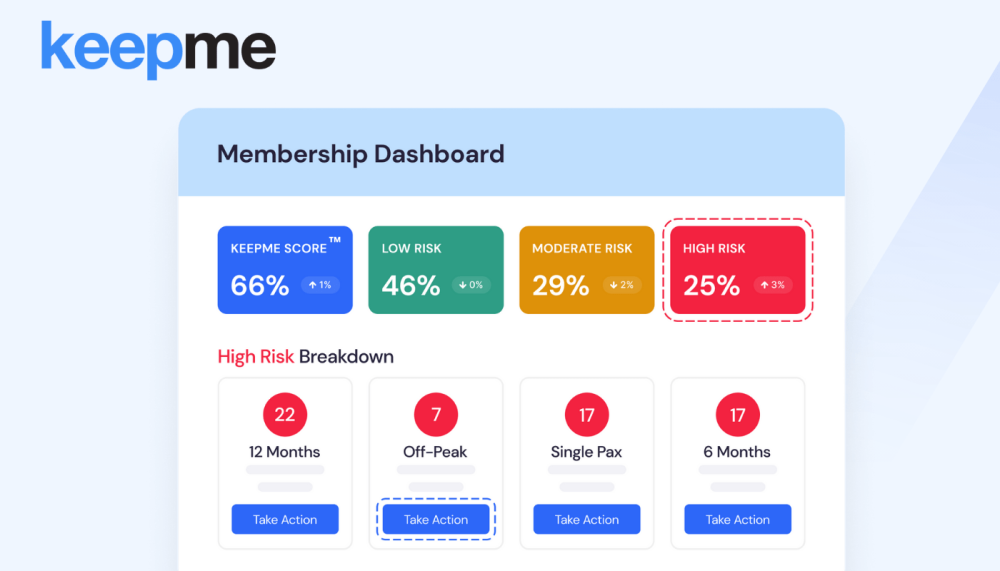How to Calculate Your Membership Retention Rate


Updated: 10th June 2024
Gym membership retention is essential for sustaining long-term revenue in the fitness industry. Member acquisition is, of course, important because without new gym members, you can’t turn them into loyal, retained members.
However, an overemphasis on acquisition drives up operating costs while doing nothing to keep existing members happy.
The danger is that membership becomes a conveyor belt where new members are fed in at one end, with disillusioned, unhappy members falling out at the other.
In the middle are members who could be falling out of love with the fitness center they chose to join.
Let’s not lose sight of the fact that competition in the fitness industry is fierce and getting fiercer. According to Statista, the global fitness industry was valued at $96.7 billion in 2022 with predictions point towards a further $35.2 billion by 2028, bringing the total to $131.9 billion.
To make matters more complicated, Zippia reports that that the larger, all-inclusive, fitness centers are competing against boutique studios. These smaller studios currently control 42% of all gym memberships.
So not only is the industry growing, and demand increasing, but larger, more established fitness centers are being forced to adapt to compete with these smaller, more specialist operators.
It’s rare for there to be just one fitness center within your target market’s commuting distance. It’s important, therefore, for operators to recognize that there isn’t a bottomless supply of new joiners. And even if there was, they’re not the only game in town.
Moreover, members talk. Unhappy members talk a lot.
Why Your Membership Retention Matters
Retained members are essential to any fitness operator for three very good reasons.
Firstly, they’re paying customers. Never lose sight of the fact that while your sales teams are chasing down new members, your existing ones are paying their salaries.
For that reason alone, retained members should be valued and respected by everyone in your employ.
Secondly, they’re more profitable. A member who renews for a year is far more profitable than a new member, purely because you haven’t had to spend money to attract them.
Furthermore, increasing retention by as little as 5% can increase profits by a minimum of 25%. When you consider the rising cost of acquisition, that isn’t to be sniffed at.
In 2018, in a report shared by IHRSA, the cost of acquisition sat at a median of $66.48 per member. However, a report from Profitwell from 2019, stated the cost of acquisition increased by 60%. Significantly, a survey by HCM in 2021, highlighted that 50% of respondents didn’t know what their Customer Acquisition Costs were.
So, assuming both pieces of information were accurate, the average cost of acquisition would have sat around $106.37 in 2019. If we were to assume costs continued to grow at the same rate, the cost of acquisition would sit at around $690 at the time of writing.
However, the more likely scenario is acquisition costs would have stabilized following the pandemic and would sit at around an average of $300-400 instead.
Considering the average monthly membership of gyms in the US sits at around $55, fitness centers aren’t making any money until month six. That’s holding to the assumption that costs didn’t continue to increase at a rate of 60% year on year.
The third reason membership retention matters is because retained members are the core of your gym community. Members who have been with you for years help to create a healthy, positive environment that invites new members in.
If your gym, on the other hand, is a revolving door of new members in and old members out, then there’s no ‘atmosphere’ and members don’t feel a social pull to stay.
Calculating your Customer Acquisition Cost
Before you dig into your membership retention, it’s important to understand what your customer acquisition cost (CAC) is. The numbers above are averages so may vary wildly from the kind of numbers your fitness center may be seeing.
The calculation is quite simple. Take your total marketing spend and divide it by the total number of new members you’ve acquired that month.
Marketing spend includes, but is not limited to:
Marketing salaries (as this essentially equates to X total hours a month spent on marketing the business)
Total Ad spend (including Google Ads, Social Media ads, and any other paid form of advertising
Other costs like email marketing platforms, social media scheduling tools, and anything else that has an annual or monthly cost attached
Any paid-for analytics or reporting tools
So let’s take a large fitness center servicing a wide area, with thousands of members, as an example. Their costs could look something like this:
Salaries - $8000 pcm
Total ad spend - $2000 pcm
Marketing tools and other costs - $750 pcm
Total monthly marketing spend - $10750
The number of new members acquired for the period is 16 (based on 40 leads and an average conversion rate of 40%).
Therefore, the customer acquisition cost, per lead is $671.87

Calculating your Cost of Attrition and Membership Retention Rates
The cost of retaining your members is minimal. Although they receive emails and other communications, those costs are insignificant compared to the revenue a retained member generates.
More importantly, consider how much it costs when a member leaves. For every member who quits your gym, it’s not just their monthly membership fee you lose. You also lose their membership fee for the entire year and any additional revenue from ancillary sales. Furthermore, you need to consider the cost of acquiring a new member to replace them.
In this example, the Member Attrition Cost can be calculated as follows:
Average monthly membership revenue: $55
Average monthly ancillary sales: $41
Average membership duration: 12 months
Customer Acquisition Cost: $67.87
Attrition Cost per Member:
($55+$41) × 12 + $67.87 = $1219.87
This means the yearly cost of attrition per member is $1219.87.

Calculating Retention
So, retention is awesome. Gym membership retention represents both a reliable revenue stream and a measure of how successful your fitness center is.
Essentially, if you’re retaining gym members then, chances are, they’re happy with the service you’re providing them.
To work out your Monthly Member Retention Rate you need to calculate the following:
((ME-MN)/MS) x 100
ME = Members at the end of the month
MN = New members acquired that month
MS = Members at the start of the month

Specify the Time Period
Before you can calculate your membership retention rate, you need to define the time period. This can be monthly, quarterly, or annually. The action you intend on taking once you have the results will inform how granular you need to be.
If you don’t have it already, it’s also useful to calculate the retention rate for the same time last year. This will help you to identify any seasonal trends or socioeconomic factors that may be affecting membership behavior.
Members
Once you know the time period you’re looking at, you can determine how many members you had at the end of that period. This is the ME (members existing) part of the formula.
Then look up how many new members you acquired during the same period. This is MN (members new) in the formula and is deducted from your total members as they aren’t retained. Yet.
This is the first stage of the calculation.
Deduct the total number of new members from your total members at the end of the period.
Next, you need to know how many members you had at the start of your specified period. This is the MS (members at the start) part of the formula.
For the next stage of the calculation, take the result of the first calculation and divide it by the number of members at the start of the period.
Converting to a Percentage
Finally, to turn that value into a percentage, simply multiply it by 100.
Example
ME (Member at the end of Q1) - 1000
MN (New members acquired during Q1 - 150
MS (Members at the start of Q1) - 1200
((1000-150)/1200) x 100 = 70.8%
According to the FBA, the average retention rate is between 60 and 70%. So, in the example above, the operator doesn’t have too much to worry about. However, 29.2% is still a big chunk of people canceling their memberships and a big hole for sales to fill.
What to do if you’re Membership Retention is Dropping
Firstly, don’t panic. Do some deeper analysis to determine if this is a blip or a trend. Break out those retention rates to look at them at a monthly level and compare them to the previous year/s.
If there is evidence that February is always a bad month for retention then you may not need to worry. But if there is evidence of a steady decline in membership retention year-on-year, then you need to take steps.
Improving your gym membership engagement is the best way to stem the loss of members.
How you do this depends heavily on the data and the technology at your disposal.
Assuming you’ve got a membership engagement platform with your membership data centralized, then membership engagement gets much easier.
When it comes to members, one source of truth, in the form of a unified membership profile is key. With all their information in one place, you can segment that data to better understand and communicate with your members.
Without that insight then membership engagement is going to be an uphill battle.
So, assuming you have your data in one place, you can build out highly personalized automation to engage with your members.
Everything from membership duration and number of visits, to classes attended and purchases will be in that membership profile.
Using automation you can create personalized nurture sequences that offer members tips, health advice, additional services, and products relevant to them and their fitness journey.
Research by Gitnux suggests that offering members a free guest pass can increase retention by as much as 20%. So, if you know your members have partners or spouses, use this to your advantage.
The more targeted you can be, the more your communications will resonate and inspire action.
Learn more about how to boost your email engagement rates.
Membership Retention and AI
Artificial intelligence can be a huge boon to operators trying to get a handle on their membership retention. AI can be used to write content including blogs and emails, allowing you to produce a repository of value-adding content, and create campaigns to engage your audience.
AI can also predict with around 95% accuracy which members are going to churn. By adding in triggers to your automation, engagement campaigns can be sent the moment the AI moves a member into that ‘at risk’ bucket.
This is significant because it allows you to take action and change behavior before those members reach the point of no return.
Using the AI to predict which members are going to be an issue for membership retention, then creating automated campaigns that trigger when specific criteria are met can:
Save time
Lower costs
Increase retention
Sustain or increase revenue
Boost profits
To learn more about how AI and automation can transform your membership retention strategy, have a chat with a member of the team, and they can run through a demo of the Keepme platform.
Transform your member retention!
Learn more about how AI and automation can boost membership retention in your fitness center.
---3.png)





